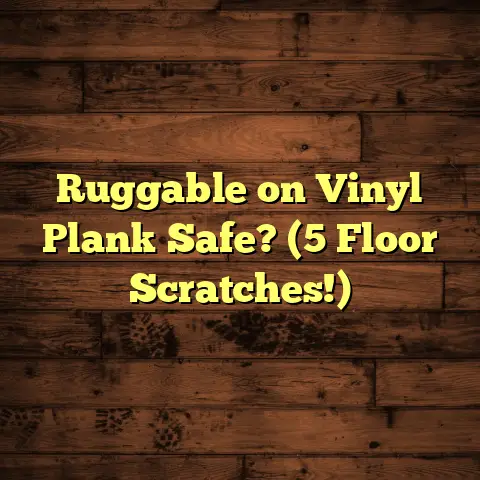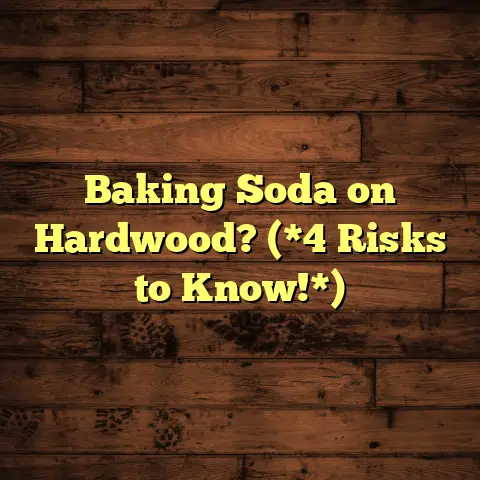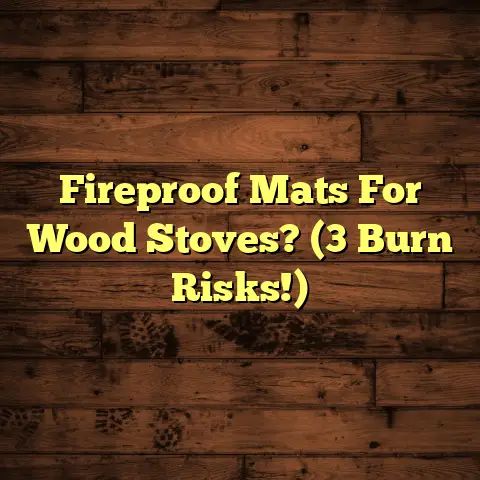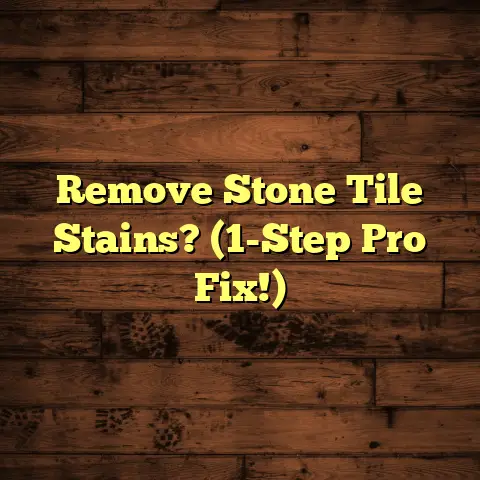Will Swiffer Ruin Laminate? (1 Mistake = Ruin!)
Laminate flooring is a fantastic choice for
many reasons.
It’s durable, resists scratches,
and beautifully mimics the look of real wood
or stone.
But here’s the thing: even the toughest
laminate can be vulnerable if you don’t treat
it right, especially when it comes to cleaning.
You see, I’ve seen firsthand the damage that
can occur from using the wrong products or
methods.
And one of the biggest culprits?
The ever-popular Swiffer.
Now, I’m not saying Swiffers are evil incarnate,
but using them incorrectly on laminate can lead
to some serious headaches.
So, let’s dive in
and uncover the truth about Swiffers and
laminate flooring.
I’ll show you how to keep
your floors looking their best for years to come!
Section 1: Understanding Laminate Flooring
Okay, before we get into the nitty-gritty of Swiffer usage, let’s make sure we’re all on the same page about laminate flooring itself.
1. Composition and Design
What exactly is laminate flooring?
Well, it’s
a multi-layered synthetic flooring product fused
together through a lamination process.
Think of
it like a super-durable, high-tech sandwich!
Here’s a breakdown of the layers:
- Backing Layer: This is the foundation, providing stability and moisture resistance.
- Core Layer: Usually made of high-density fiberboard (HDF) or medium-density fiberboard (MDF), this layer gives the floor its strength and impact resistance.
- Design Layer: This is where the magic happens!
A high-resolution photographic image of wood, stone, or tile is printed on this layer. - Wear Layer: This is the top protective layer, a clear coating that resists scratches, stains, and fading.
The manufacturing process involves pressing these
layers together under high heat and pressure, creating
a tough and resilient flooring material.
This process
is what gives laminate its durability and its ability
to mimic the look of natural materials so convincingly.
2. Benefits of Laminate Flooring
Why is laminate so popular?
I’ve installed miles
of it, and here’s what I’ve learned:
- Affordability: Compared to hardwood or natural stone, laminate is significantly more budget-friendly.
- Ease of Installation: Many laminate floors feature click-lock systems, making DIY installation a breeze.
I’ve seen homeowners transform entire rooms in a weekend! - Versatility in Design: Laminate comes in a massive range of styles, colors, and textures.
You can find a laminate that perfectly matches your aesthetic. - Durability: Laminate is designed to withstand heavy foot traffic, scratches, and stains.
It’s a great choice for busy households with kids and pets.
According to Statista, laminate flooring accounts
for a significant portion of the flooring market,
with sales reaching billions of dollars annually.
This popularity speaks volumes about its appeal
and practicality.
3. Common Misconceptions
Now, let’s bust some myths! I often hear these misconceptions about laminate:
- “Laminate is cheap and flimsy.” Not true!
High-quality laminate can be incredibly durable and long-lasting. - “Laminate looks fake.” While early laminates might have had a less-than-realistic appearance, modern technology has made huge strides.
Many laminates now feature embossed textures and realistic grain patterns. - “Laminate is waterproof.” This is a big one!
While some laminates are water-resistant, no laminate is truly waterproof.
Excessive moisture can cause swelling and damage.
It’s important to understand the difference between
laminate and other flooring types.
Hardwood is solid
wood, while laminate is a synthetic product.
Vinyl
is another synthetic option, but it’s typically more
water-resistant than laminate.
Knowing these differences
will help you choose the right flooring for your needs.
Section 2: Cleaning Laminate Flooring
Alright, now that we’ve covered the basics of
laminate, let’s talk about cleaning.
This is
where things can get tricky!
1. General Cleaning Guidelines
The key to keeping your laminate floors looking
great is regular and proper cleaning.
Here are
some general guidelines I always recommend:
- Sweep or vacuum regularly: This removes dirt, dust, and debris that can scratch the surface.
- Use a damp mop: Never use a soaking wet mop!
Excess water can seep into the seams and cause damage. - Use a pH-neutral cleaner: Avoid harsh chemicals, abrasive cleaners, and anything that contains wax or oil.
- Clean up spills immediately: Don’t let spills sit on the surface for long periods.
- Protect your floors: Use mats at entrances to trap dirt and place felt pads under furniture legs to prevent scratches.
2. Swiffer and Its Popularity
Swiffer has become a household name, and for
good reason.
It’s convenient, easy to use, and
marketed as a quick and effective cleaning solution.
Swiffer offers a range of products, including:
- Swiffer Sweeper: A dry sweeping tool that uses disposable cloths to pick up dust and dirt.
- Swiffer WetJet: A spray mop that dispenses a cleaning solution onto the floor.
- Swiffer Duster: A tool for dusting surfaces, including floors.
The appeal of Swiffer lies in its simplicity.
It’s
a quick and easy way to clean up messes without
the hassle of traditional mops and buckets.
This
convenience has made it a popular choice for busy
households.
3. Potential Risks of Using Swiffer on Laminate
Here’s where the rubber meets the road.
While
Swiffer can be convenient, certain products and
methods can be detrimental to laminate flooring.
The biggest concerns are:
- Harsh Chemicals: Some Swiffer WetJet solutions contain chemicals that can dull the finish of laminate floors over time.
- Excessive Moisture: The Swiffer WetJet can sometimes dispense too much liquid, which can seep into the seams and cause swelling.
- Residue Buildup: Some cleaning solutions can leave behind a sticky residue that attracts dirt and makes the floor look dull.
I’ve seen countless cases where homeowners have
damaged their laminate floors by using the Swiffer
WetJet improperly.
The most common issue is warping
around the edges of the planks, caused by excessive
moisture seeping into the seams.
This damage is often
irreversible and requires costly repairs or replacements.
Section 3: The One Mistake That Can Ruin Laminate
Okay, let’s cut to the chase.
What’s the one
mistake that can truly ruin your laminate floors?
1. Identifying the Critical Mistake
The critical mistake is using inappropriate cleaning solutions or excessive water. It sounds simple, but it’s a mistake I see repeated time and time again.
This mistake manifests in everyday cleaning routines in several ways:
- Using the Swiffer WetJet and saturating the floor with cleaning solution.
- Using generic cleaning sprays that aren’t specifically designed for laminate.
- Using a traditional mop that’s too wet.
- Ignoring spills and allowing them to sit on the floor for extended periods.
2. Consequences of This Mistake
The consequences of this mistake can be devastating.
Here are some potential long-term effects on your
laminate flooring:
- Warping: Excessive moisture can cause the core layer of the laminate to swell, leading to warping and buckling.
- Peeling: The edges of the laminate planks can start to peel and separate.
- Dulling: Harsh chemicals can strip the protective wear layer, making the floor look dull and faded.
- Discoloration: Some cleaning solutions can react with the laminate and cause discoloration.
- Mold and Mildew: Trapped moisture can create a breeding ground for mold and mildew.
I once had a client who used the Swiffer WetJet
religiously on their laminate floors.
Over time,
the floors started to warp and peel, and they
ended up having to replace the entire flooring
system in their kitchen.
The cost?
Thousands of dollars.
3. Signs of Damage
How can you tell if your laminate flooring has
been compromised?
Here are some visible signs to
look out for:
- Bubbling: Small bubbles appearing on the surface of the laminate.
- Warping: The planks lifting or buckling.
- Discoloration: Changes in the color of the laminate.
- Peeling: The edges of the planks separating.
- Swelling: The planks feeling soft or spongy.
If you notice any of these signs, it’s important
to take action immediately.
Assess the extent of
the damage and consider seeking professional help.
A flooring contractor can evaluate the situation
and recommend the best course of action, whether
it’s repairing a small area or replacing the entire floor.
Section 4: Alternatives to Swiffer for Cleaning Laminate
Okay, so if Swiffer isn’t always the best choice,
what are the alternatives?
Don’t worry, I’ve got
you covered!
1. Safe Cleaning Products
When it comes to cleaning laminate, it’s best to
stick to products specifically designed for this
type of flooring.
Look for pH-neutral cleaners
that won’t damage the finish.
Here are some of my favorite safe cleaning products:
- Bona Hardwood Floor Cleaner: While marketed for hardwood, this cleaner is also safe and effective on laminate.
- Armstrong Hardwood and Laminate Floor Cleaner: A trusted brand specifically designed for laminate floors.
- Method Squirt + Mop Hard Floor Cleaner: A plant-based cleaner that’s gentle and effective.
I also highly recommend using microfiber cloths and
mops.
Microfiber is incredibly absorbent and won’t
scratch the surface of your laminate floors.
2. Homemade Cleaning Solutions
If you’re looking for a more natural approach,
you can easily make your own cleaning solutions
at home.
Here are a couple of simple recipes:
- Vinegar and Water: Mix 1/4 cup of white vinegar with 1 gallon of warm water.
- Dish Soap and Water: Add a few drops of mild dish soap to 1 gallon of warm water.
When using homemade solutions, always test them
on a small, inconspicuous area first to make sure
they don’t damage the floor.
And remember, less
is more!
Use a damp mop, not a soaking wet one.
3. Best Practices for Maintaining Laminate Flooring
In addition to regular cleaning, there are other things you can do to maintain the beauty and longevity of your laminate floors:
- Sweep or vacuum regularly: This prevents dirt and debris from scratching the surface.
- Use mats at entrances: This traps dirt and moisture before they can reach your floors.
- Place felt pads under furniture legs: This prevents scratches and dents.
- Avoid wearing shoes indoors: Shoes can track in dirt and debris that can damage the floor.
- Clean up spills immediately: Don’t let spills sit on the surface for long periods.
- Avoid using steam mops: Steam can damage the laminate and cause warping.
By following these best practices, you can keep your laminate floors looking their best for years to come.
Conclusion
So, will Swiffer ruin laminate?
The answer is:
it depends.
While the Swiffer Sweeper is generally
safe for dry dusting, the Swiffer WetJet can be
risky if used improperly.
The key is to avoid
excessive moisture and harsh chemicals.
Laminate flooring is a durable and beautiful
choice for any home, but it requires proper care
and maintenance.
By understanding the potential
risks of using products like Swiffer and adopting
safe cleaning practices, you can ensure the
longevity of your floors.
Remember, a little caution goes a long way.
By
taking the time to clean your laminate floors
properly, you can prevent costly mistakes and
preserve their beauty and functionality for years
to come.
And that, my friends, is worth the effort!





